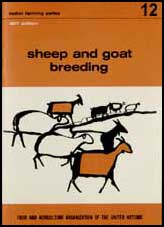
Knowing the flock and maintaining it[edit | edit source]
How to know your flock[edit | edit source]
We have seen how important it is to choose good breeding animals.
The good qualities of the parents and grandparents are passed on to the offspring.
In modern animal husbandry you choose good breeding animals. By knowing the parents, you select.
Modern farmers put a mark on each animal in the flock. Give each animal a number - this is its name.
Mark the number on the back of the animal by cutting the wool with a pair of shears.
For example, mark A on the male. On the females mark 1, 2, 3, etc.
On the young animals mark A1, if, for example, the sire is A and the dam is 1.
You can tell from which litter of dam 1 the offspring comes by marking a second number. For example, if A1 is from the third litter, it is marked A13, and so on.
Keep a herd book
Keep a herd book, as modern farmers do. Take a double page for each animal. Write on it all you need to know about each animal in the flock.
Name of ram: A
Month and year of birth: mid- July 1964
Son of...............: and of: .....................
|
Date of service |
Name of ewe |
Number of offspring |
Remarks |
|
Vaccination Oct. 1964, | |||
|
6 Oct. 1965 |
3 |
2 |
Eat. more before service. |
|
10 Oct. 1965 |
2 |
1 |
Lambs well |
|
17 Oct. 1965 |
1 |
2 |
formed. |
Example of herd book page for a ewe
Name of ewe: A1
Month and year of birth: March 1966
Daughter of: A and of: 1
|
Data of service |
Name of ram |
Dates of birth |
Number of offspring per litter |
Remarks |
|
5 Sep. 1967 |
Hira |
|
2 |
Lambs vaccinated for enterotoxaemia. |
|
2 lambs died before weaning. | ||||
|
28 Aug. 1868 |
Mou |
20..69 |
2 |
Lambs vaccinated. |
|
Weaned beginning July 1969. |
Example of herd book page for lambs
Name of animal: A1
Month and year of birth: March 1966
|
Date of service |
Date of births |
No. of lambs per litter |
No. of lambs dead before weaning |
Remarks |
|
5 Sep. 1967 |
|
2 |
2 |
A1 vaccinated 15.5.66. |
|
Lambs vaccinated for enterotoxaemia. | ||||
|
20 Aug. 1868 |
20.1.69 |
2 |
0 |
Lambs vaccinated. |
|
Weaned beginning July 1969. |
You know more or less the date of birth of any animal you have bought.
The fourth column shows the deaths among the stock; you can see if each dam has many deaths among her offspring.
If the dam has deaths in each litter, she should be fattened and sold.
With the book a farmer knows at any time the state of his flock.
The veterinary assistant writes in the herd book what he has done, and what the farmer. is to do.
The farmer writes down roughly how much food is given per day, without counting grass.
He knows what each animal has eaten before it is sold.
So he knows how much food is needed in a year for his flock.
He also makes notes on the animals.
He has a record of each breeding animal and can tell which are the best animals.
He fattens and eats or sells those which are not earning.
This is what is meant by selection. He knows his flock and knows what it earns.